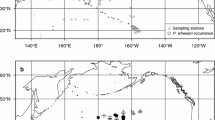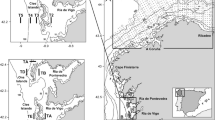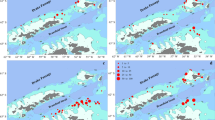Synopsis
Counts of pre-metamorphic and post-metamorphic daily increments in the sagittae of settled juvenilePagrus auratus were used to determine duration of the larval period and to back-calculate spawning dates. The duration of the larval period was 18–32 days, and was longer for snapper spawned early in the spawning season, when water temperatures were low, than for snapper spawned later in the season when temperatures were high. Sagitta size at metamorphosis was unrelated to duration of the larval period or temperature, and mean increment width during the larval period increased with temperature. These results suggest that metamorphosis is size- rather than age-dependent. Back-calculated spawning dates ranged from September to March, and peaked in November-January. Maximum spawning season duration was five months. Spawning onset was earlier when spring water temperature was higher than normal, and first spawning occurred at 14.8–15.6 °C over three seasons, indicating that spawning onset is temperature-dependent.
Similar content being viewed by others
References cited
Al-Hossaini, M., Q. Liu & T.J. Pitcher. 1989. Otolith microstructure indicating growth and mortality among plaice,Pleuronectes platessa L., post-larval sub-cohorts. J. Fish Biol. 35: 81–90.
Atkinson, M.H. 1987. Ontogenetic patterns in presettlementChrysophrys auratus (Sparidae). M.Sc. Thesis, University of Auckland, Auckland. 85 pp.
Bradford, M.J. & G.H. Geen. 1992. Growth estimates from otolith increment widths of juvenile chinook salmon (Oncorhynchus tshawytscha) reared in changing environments. J. Fish Biol. 41: 825–832.
Brothers, E.B., C.P. Mathews & R. Lasker. 1976. Daily growth increments in otoliths from larval and adult fishes. U.S. Fish. Bull. 74: 1–8.
Brothers, E.B. & W.N. McFarland. 1981. Correlations between otolith microstructure, growth, and life history transitions in newly recruited French grunts [Haemulon flavolineatum (Desmarest), Haemulidae]. Rapp. Proc.-Verb. Réun, Cons. Perm. Int. l'Exp. Mer 178: 369–374.
Campana, S.E. 1984. Microstructural growth patterns in the otoliths of larval and juvenile starry founder,Platichthys stellatus. Can. J. Zool. 62: 1507–1512.
Campana, S.E., K.T. Frank, P.C.F. Hurley, P.A. Koeller, F.H. Page & P.C. Smith. 1989. Survival and abundance of young Atlantic cod (Gadus morhua) and haddock (Melanogrammus aeglefinus) as indicators of year-class strength. Can. J. Fish. Aquat. Sci. 46 (supplement 1): 171–182.
Campana, S.E., J.A. Gagnè & J. Munro. 1987. Otolith microstructure of larval herring (Clupea harengus): image or reality? Can. J. Fish. Aquat. Sci. 44: 1922–1929.
Campana, S.E. & P.C. Hurley. 1989. An age- and temperature-mediated growth model for cod (Gadus morhua) and haddock (Melanogrammus aeglefinus) larvae in the Gulf of Maine. Can. J. Fish. Aquat. Sci. 46: 603–613.
Campana, S.E. & J.D. Neilson. 1985. Microstructure of fish otoliths. Can. J. Fish. Aquat. Sci. 42: 1014–1032.
Cassie, R.M. 1956a. Early development of the snapper,Chrysophrys auratus Forster. Trans. Roy. Soc. N.Z. 83: 705–713.
Cassie, R.M. 1956b. Spawning of the snapper,Chrysophrvs auratuts Forster in the Hauraki Gulf. Trans. Roy. Soc. N.Z. 84: 309–328.
Chambers, R.C. & W.C. Leggett. 1987.
Crossland, J. 1977. Seasonal reproductive cycle of snapperChrysophrys auratus (Forster) in the Hauraki Gulf. N.Z. J. Mar. Freshwat. Res. 11: 37–60.
Crossland, J. 1980. The number of snapper,Chrysophrys auratus (Forster), in the Hauraki Gulf, New Zealand, based on egg surveys in 1974–75 and 1975–76. New Zealand Ministry of Agriculture and Fisheries, Fish. Res. Bull. 22, 38 pp.
Crossland, J. 1981. The biology of the New Zealand snapper. New Zealand Ministry of Agriculture and Fisheries Occ. Pub. 23. 15 pp.
Day, R.W. & G.P. Quinn. 1989. Comparisons of treatments after an analysis of variance in ecology. Ecol. Monogr. 59: 433–463.
Foscarini, R. 1988. A review: intensive farming procedure for red sea bream (Pagrus major) in Japan. Aquaculture 72: 191–246.
Francis, M.P. 1992. Population dynamics of juvenile snapper (Pagrus auratus) in the Hauraki Gulf. Ph.D. Thesis, University of Auckland, Auckland. 337 pp.
Francis, M.P. 1993. Does water temperature determine year class strength in New Zealand snapper (Pagrus auratus, Sparidae)? Fish. Oceanogr. 2: 65–72.
Francis, M.P, M.W. Williams, A.C. Pryce, S. Pollard & S.G. Scott. 1992. Daily increments in otoliths of juvenile snapper,Pagrus auratus (Sparidae). Aust. J. Mar. Freshwat. Res. 43: 1015–1032.
Francis, M.P, M.W. Williams, A.C. Pryce, S. Pollard & S.G. Scott. 1993. Uncoupling of otolith and somatic growth inPagrus auratus (Sparidae). U.S. Fish. Bull. 91: 159–164.
Fukuhara, O. 1985. Functional morphology and behaviour of early life stages of red sea bream. Bull. Jap. Soc. Scient. Fish. 51: 731–743.
Fukuhara, O. 1991. Size and age at transformation in red sea bream,Pagrus major, reared in the laboratory. Aquaculture 95: 117–124.
Gulland, J.A. 1965. Survival of the youngest stages of fish and its relation to year class strength. I.C.N.A.F Spec. Pub. 6: 365–371.
Gutiérrez, E. & B. Morales-Nin. 1986. Time series analysis of daily growth inDicentrarchus labrax L. otoliths. J. Exp. Mar. Biol. Ecol. 103: 163–179.
Houde, F.D. 1987. Fish early life dynamics and recruitment variability. Amer. Fish. Soc. Symp. 2: 17–29.
Houde, E.D. 1989. Comparative growth, mortality, and energetics of marine fish larvae: temperature and implied latitudinal effects. U.S. Fish. Bull. 87: 471–495.
Hovenkamp, F. 1991. Immigration of larval plaice (Pleuronectes platessa L.) into the western Wadden Sea: a question of timing. Neth. J. Sea Res. 27: 287–296.
Hovenkamp, F. & J.I. Witte. 1991. Growth, otolith growth and RNA/DNA ratios of larval plaicePleuronectes platessa in the North Sea 1987 to 1989. Mar. Ecol. Progr. Ser. 70: 105–116.
Jones, C. 1986. Determining age of larval fish with the otolith increment technique. U.S. Fish. Bull. 84: 91–103.
Karakiri, M., R. Berghahn & H.W. van der Veer. 1991. Variations in settlement and growth of 0-group plaice (Pleuronectes platessa L.) in the Dutch Wadden Sea as determined from otolith microstructure analysis. Neth. J. Sea Res. 27: 345–351.
Kinoshita, I. & M. Tanaka. 1990. Differentiated spatial distribution of larvae and juveniles of the two sparids, red and black sea bream, in Shijiki Bay. Nippon Suisan Gakkaishi 56: 1807–1813.
Kojima, K. 1981. Spawning of the red sea bream (Pagrus major) in the waters around Iki Is. and Mishima Is. in the western part of the Japan Sea. Bull. Seikai Reg. Fish. Res. Lab. 56: 71–87.
Laurence, G.C. 1975. Laboratory growth and metabolism of the winter flounderPseudopleuronectes americanus from hatching through metamorphosis at three temperatures. Mar. Biol. 32: 223–229.
McGurk, M.D. 1986. Natural mortality of marine pelagic fish eggs and larvae: role of spatial patchiness. Mar. Ecol. Progr. Ser. 34: 227–242.
Molony, B.W. & J.H. Choat. 1990. Otolith increment widths and somatic growth rate: the presence of a time-lag. J. Fish Biol. 37: 541–551.
Mosegaard, H., H. Svedäng & K. Taberman. 1988. Uncoupling of somatic and otolith growth rates in Arctic char (Salvelinus alpinus) as an effect of differences in temperature response. Can. J. Fish. Aquat. Sci. 45: 1514–1524.
Neilson, J.D. & G.H. Geen. 1985. Effects of feeding regimes and diel temperature cycles on otolith increment formation in juvenile chinook salmon,Oncorhynchus tshawytscha. U.S. Fish. Bull. 83: 91–101.
Pankhurst, P.M., J.C. Montgomery & N.W. Pankhurst. 1991. Growth, development and behaviour of artificially reared larvalPagrus auratus (Bloch and Schneider, 1801) (Sparidae). Aust. J. Mar. Freshwat. Res. 42: 391–398.
Pannella, G. 1971. Fish otoliths: daily growth layers and periodical patterns. Science 173: 1124–1127.
Paul, L.J. 1968. Some seasonal water temperature patterns in the Hauraki Gulf, New Zealand. N. Z. J. Mar. Freshwat. Res. 2: 535–558.
Paul, L.J. 1976. A study on age, growth, and population structure of the snapper,Chrysophrys auratus (Forster), in the Hauraki Gulf, New Zealand. New Zealand Ministry of Agriculture and Fisheries, Fish. Res. Bull. 13. 62 pp.
Paulin, C.D. 1990.Pagrus auratus, a new combination for the species known as ‘snapper’ in Australasian waters (Pisces: Sparidae). N. Z. J. Mar. Freshwat. Res. 24: 259–265.
Pepin, P. 1991. Effect of temperature and size on development, mortality, and survival rates of the pelagic early life history stages of marine fish. Can. J. Fish. Aquat. Sci. 48: 503–518.
Pepin, P & R.A. Myers. 1991. Significance of egg and larval size to recruitment variability of temperate marine fish. Can. J. Fish. Aquat. Sci. 48: 1820–1828.
Policansky, D. 1982. Influence of age, size, and temperature on metamorphosis in the starry flounder,Platichthys stellatus. Can. J. Fish. Aquat. Sci. 39: 514–517.
Reznick, D., E. Lindbeck & H. Bryga. 1989. Slower growth results in larger otoliths: an experimental test with guppies (Poecilia reticulata). Can. J. Fish. Aquat. Sci. 46: 108–112.
Scott, S.G. & N.W. Pankhurst. 1992. Interannual variation in the reproductive cycle of the New Zealand snapperPagrus auratus (Bloch & Schneider) (Sparidae). J. Fish Biol. 41: 685–696.
Scott, S.G., J.R. Zeldis & N.W. Pankhurst. 1993. Evidence of daily spawning in natural populations of the New Zealand snapperPagrus auratus (Sparidae). Env. Biol. Fish. 36: 149–156.
Secor, D.H. & J.M. Dean. 1989. Somatic growth effects on the otolith-fish. size relationship in young pond-reared striped bass,Morone saxatilis. Can. J. Fish. Aquat. Sci. 46: 113–121.
Secor, D.H., J.M. Dean & R.B. Baldevarona. 1989. Comparison of otolith growth and somatic growth in larval and juvenile fishes based on otolith length/fish length relationships. Rapp. Proc.-Verb. Réun. Cons. Perm. Int. l'Exp. Mer 191: 431–438.
Sissenwine, M.P. E.B. Cohen & M.D. Grosslein. 1984. Structure of the Georges Bank ecosystem. Rapp. Proc.-Verb. Réun. Cons. Perm. Int. l'Exp. Mer 183: 243–254.
Smith, P.E. 1985. Year-class strength and survival of 0-group clupeoids. Can. J. Fish. Aquat. Sci. 42 (supplement 1): 69–82.
Sokal, R.R. & F.J. Rohlf. 1981 Biometry. The principles and practice of statistics in biological research. Second edition. W.H. Freeman, San Francisco. 859 pp.
Tanaka, M. 1985. Factors affecting the inshore migration of pelagic larval and demersal juvenile red sea breamPagrus major to a nursery ground. Trans. Amer. Fish. Soc. 114: 471–477.
Taubert, B.D. & D.W. Coble. 1977. Daily rings in otoliths of three species ofLepomis andTilapia mossambica. J. Fish. Res. Board Can. 34: 332–340.
Templeman, W. & H.J. Squires. 1956. Relationship of otolith lengths and weights in the haddockMelanogrammus aeglefinus (L.) to the rate of growth of the fish. J. Fish. Res. Board Can. 13: 467–487.
Tsuji, S. & T. Aoyama. 1982. Daily growth increments observed in otoliths of the larvae of Japanese red sea breamPagrus major (Temminck et Schlegel). Bull. Jap. Soc. Scient. Fish. 48: 1559–1562.
Victor, B.C. 1982. Daily otolith increments and recruitment in two coral-reef wrasses,Thalassoma bifasciatum andHalichoeres bivittatus. Mar. Biol. 71: 203–208.
Victor, B.C. 1986. Duration of the planktonic larval stage of one hundred species of Pacific and Atlantic wrasses (family Labridae). Mar. Biol. 90: 317–326.
Wellington, G.M. & B.C. Victor. 1989. Planktonic larval duration of one hundred species of Pacific and Atlantic damselfishes (Pomacentridae). Mar. Biol. 101: 557–567.
Wellington, G.M. & B.C. Victor. 1992. Regional differences in duration of the planktonic larval stage of reef fishes in the eastern Pacific Ocean. Mar. Biol. 113: 491–498.
Wright, P.J. 1991. The influence of metabolic rate on otolith increment width in Atlantic salmon parr,Salmo salar L. J. Fish. Biol. 38: 929–933.
Author information
Authors and Affiliations
Rights and permissions
About this article
Cite this article
Francis, M.P. Duration of larval and spawning periods inPagrus auratus (Sparidae) determined from otolith daily increments. Environ Biol Fish 39, 137–152 (1994). https://doi.org/10.1007/BF00004931
Received:
Accepted:
Issue Date:
DOI: https://doi.org/10.1007/BF00004931




